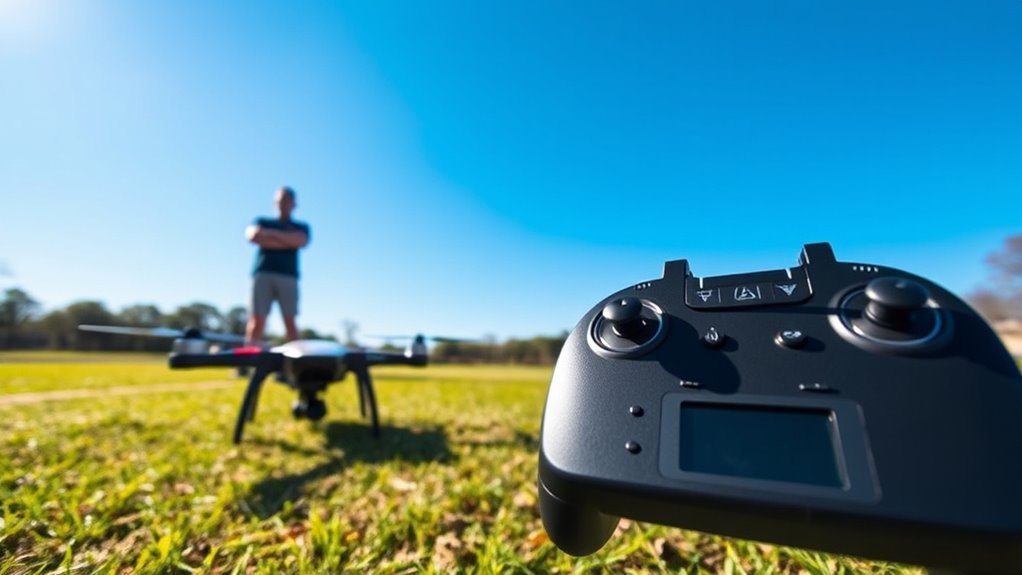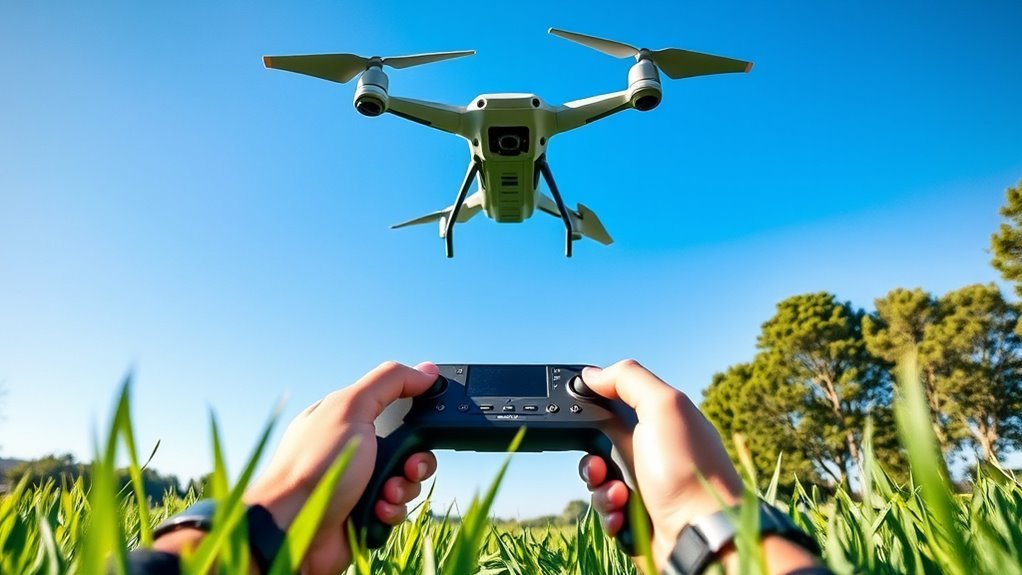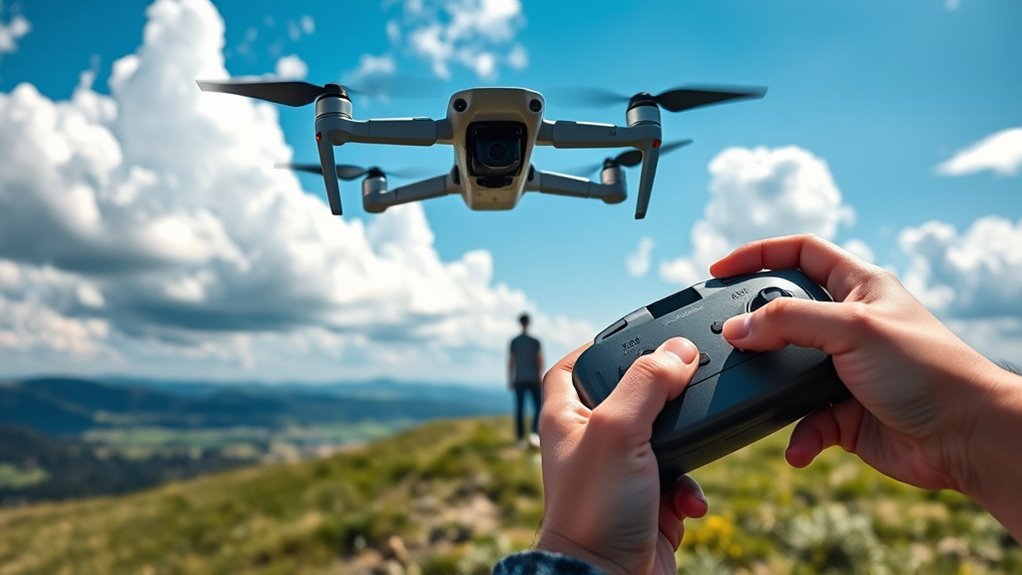To fly your Sky Rider drone, start by familiarizing yourself with its components, including the camera and battery. Before takeoff, check the battery level and assess weather conditions. Follow a pre-flight checklist to guarantee safety. Practice basic maneuvers like smooth takeoffs, landings, and gentle turns for better control. Always respect local regulations and privacy while flying. If you encounter issues, troubleshoot common problems quickly. There’s more useful information to enhance your flying experience!
Understanding Your Sky Rider Drone Components

When you first take your Sky Rider drone out of the box, it’s essential to familiarize yourself with its components to guarantee smooth operation. Start by locating the drone camera, which is critical for capturing stunning aerial footage. Check its positioning and verify it’s secure. Next, focus on battery management. Understanding how to install, charge, and monitor the battery life is fundamental for uninterrupted flying. Make sure the battery clicks into place firmly, and always keep a spare charged battery on hand for extended adventures. Additionally, the battery life can significantly impact your overall flying experience, similar to how it affects the flight capabilities of drones like the JJRC H36 and EXO Scout. Finally, familiarize yourself with the remote control and its various buttons. Knowing how each component works will empower you to take full advantage of your drone’s capabilities, giving you the freedom to explore the skies. Additionally, mastering the intuitive control system will significantly enhance your flying experience.
Preparing for Flight: Pre-Flight Checklist

Before you take to the skies, it’s essential to follow a pre-flight checklist to confirm everything’s in order. Here’s a quick rundown to guarantee a smooth flight experience with your Sky Rider drone:
| Checklist Item | Status (OK/Not OK) | Notes |
|---|---|---|
| Drone Battery Level | ||
| Flight Conditions | Wind Speed & Weather | |
| Firmware Updates |
Make sure your drone battery’s charged and the weather’s favorable. Understanding battery life helps you plan for optimal flight times. Check for any obstacles in your flight path and verify your firmware’s up to date. This preparation not only enhances your freedom in the skies but also keeps your drone safe and sound. Additionally, ensure you are aware of local regulations to avoid potential legal issues. Happy flying!
Basic Flight Maneuvers: Getting Started

As you prepare to take your drone into the air, mastering basic flight maneuvers is essential for a successful experience. Understanding your drone controls will greatly enhance your confidence and flight stability. Here are three key maneuvers to get you started:
Mastering basic flight maneuvers is crucial for confidence and stability in your drone flying experience.
- Takeoff and Landing: Practice smooth ascents and descents. Gradual movements help maintain stability.
- Hovering: Learn to keep your drone steady in one position. This builds your control skills.
- Turning: Use gentle inputs to turn your drone left or right. Quick adjustments can lead to instability. Additionally, ensuring you have a user-friendly controller interface will make these maneuvers easier to master.
Tips for Safe and Responsible Drone Flying
Flying a drone can be an exhilarating experience, but it’s crucial to prioritize safety and responsibility. Adhering to drone regulations guarantees you’re flying legally, while ethical flying practices promote respect for others and the environment. Here are some tips to take into account:
| Tip | Description | Importance |
|---|---|---|
| Check Regulations | Research local laws before flying | Avoid legal issues |
| Respect Privacy | Don’t invade others’ personal space | Build community trust |
| Fly Responsibly | Stay within visual line of sight | Enhance safety |
| Monitor Weather | Avoid flying in bad conditions | Protect your drone |
| Pre-Flight Check | Inspect your drone pre-flight | Guarantee operational safety |
It’s essential to be aware that shooting a drone can lead to significant civil liabilities and potential criminal charges. Additionally, understanding signal attenuation is vital for ensuring your drone operates effectively in various environments.
Troubleshooting Common Flight Issues
When unexpected issues arise during a drone flight, knowing how to troubleshoot them can save both your equipment and your flying experience. Here are some common problems and quick fixes:
- Battery Issues: If your drone’s flight time is shorter than expected, check the battery level. Verify it’s charged and properly connected. Replace it if it shows signs of wear. The DJI Air 3S offers up to 46 minutes of flight time, making battery management crucial for longer flights. Additionally, understanding flight duration can help you choose the right drone for your needs.
- Connectivity Problems: If you lose connection with your drone, try moving closer to it. Confirm your remote control batteries are charged, and check for any interference from nearby devices.
- GPS Signal Loss: If your drone drifts unexpectedly, it might be having trouble connecting to GPS. Land it safely and wait for a clear signal before taking off again.
These steps can help you regain control and continue enjoying your freedom in the skies.
Frequently Asked Questions
How Do I Register My Sky Rider Drone?
Imagine setting sail on a vast ocean; registering your Sky Rider drone is your anchor. To meet the drone registration process, simply visit the FAA website, ensuring you fulfill all Sky Rider requirements for safe flying.
Can I Fly My Drone at Night?
You can fly your drone at night, but you must follow night flight regulations. Always prioritize night flying safety by using proper lighting and maintaining visual line-of-sight to enjoy your freedom while staying compliant.
What Are the Legal Requirements for Drone Flying?
You need to understand drone regulations and safety guidelines before flying. Check local laws, register your drone if required, and always respect no-fly zones to guarantee you enjoy your freedom responsibly and safely.
How Long Does the Battery Last During Flight?
The battery performance of your drone typically lasts around 10 to 20 minutes, depending on usage and conditions. To maximize flight duration, keep an eye on battery levels and avoid heavy maneuvers during flight.
Is There a Warranty for the Sky Rider Drone?
Yes, there’s a warranty for the Sky Rider drone. Check the warranty details in your manual or visit the website. For any questions, customer support is ready to help you with your concerns.

